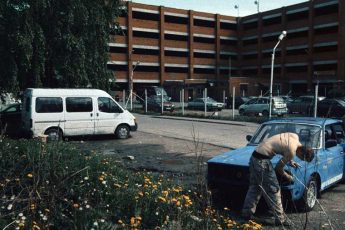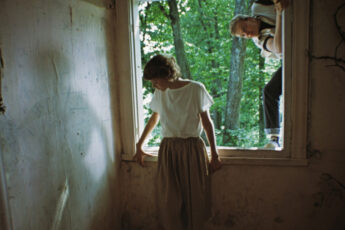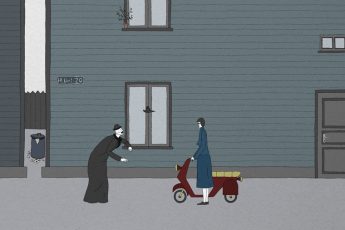
When the Baltic States were annexed by the USSR in the “second” Soviet Occupation (1944 – 1991), the new regime naturally centralized what was left of the film industries in each of the countries. While as Näripea has stated, “these centrally imposed regulations and policies […] are now often considered in the framework of a transnational discourse of complex interrelations rather than from a victimizing perspective of colonialism and Russification”1, a large portion of the early productions overseen by Moscow conspicuously avoided the first occupation (1940-1941), when the Soviets treated the local populations heavy-handedly enough that the return of the Germans almost seemed like a kind of liberation. However, the very first films produced did celebrate the final phases of World War Two, and did so as fairly simplistic propaganda.
In films such as Herbert Rappaport’s Life in the Citadel (Elu tsitadellis) or Aleksandr Ivanov’s Homeward with Victory (Mājup ar uzvaru), the first features made in Soviet Estonia and Latvia respectively, both from 1947, the roles in the dramaturgical us-them relationship are unambiguously assigned to the Soviets and the Nazis. On screen, Baltic citizens were given a binary choice of aligning with one of these two sides, with no alternative permissible stance and the inherent assumption that siding with the Germans was unthinkable. As part of the process of Sovietization, the Red Army was represented partially as a liberating force but also crucially as the home side. An emphasis was placed on the homecoming of the Baltic soldiers who fought alongside the Communists as brothers-in-arms, reinforcing the newly acquired dual national identity.
A clear example of the historiographical processes in play can be seen in Maryte (Vera Stroyeva, 1947), a dramatic re-envisioning of the life of Maryte Melnikaitė, a young woman who fought and died with the pro-Soviet partisans, after being tortured by the Nazis. In addition to exaggerating the extent of the Communist underground at that time, which was small and largely formed of forces sent in from Russia or Belarus, the choice of a woman for martyrdom is also clearly intended to invoke more sympathy and emphasize the tragedy of her loss. Moreover, by charting Maryte’s transformation from a rural Lithuanian girl into a Soviet hero there are evident implications for the country as a whole, with the implicit insinuation that this trajectory was commonplace. Tellingly, while the Muscovite crew was occupied with presenting Soviet rule as an established, accepted and even welcomed status quo, during shooting the crew feared for their safety due to constant attacks by resistance activists, who considered them collaborators.2
The early 1960s saw the return of home-grown filmmakers who had completed their training at the VGIK, who replaced the directors who had previously been shipped out by the industrial headquarters. While this new generation obviously brought with them the indoctrination they had received in Moscow, they nevertheless also brought a vital breath of fresh air and a shift in perspective. In the wake of Andrzej Wajda’s influential Ashes and Diamonds (Popiół i diament, 1958), Baltic filmmakers began daring to assess the moral dilemmas of the war and post-war periods more critically, offering psychological nuance and a humanistic portrayal of those who chose not to side with the USSR. Thematic trends shifted from liberation and jubilant homecoming to agonized clashes between pro- and anti-Soviet groups, typically represented by collective farmers and partisan movements such as the “Forest Brothers”, as in Vytautas Žalakevičius’ Nobody Wanted to Die (Niekas nenorėjo mirti, 1966) or the later Men’s Summer (Vyrų vasara, Marijonas Giedrys, 1970). 1966 saw the release of two films that employed the recurring narrative device of following the fates of former comrades in battle, comparing and contrasting their chosen allegiances and their paths, Grigori Kromanov’s What Happened to Andres Lapeteus? (Mis juhtus Andres Lapeteusega?) in Estonia and Rolands Kalniņš’ I Remember Everything, Richard! (Es visu atceros, Ričard!), which focused on the uncomfortable issue of the Latvians who were conscripted to the German army.
Despite the comparative permissiveness of the State during this thaw period regarding the discussion of political allegiances and historical events, tangible limits did remain in place. Negotiations with the censors over the production of I Remember Everything, Richard! took almost a decade from the time it was originally conceived in 1955 as Forgive Me, Homeland! (Dzimtene piedod!). As yet another marker of changing attitudes, it was also released again later with some of its cut scenes restored under the conspicuously Wajda-evoking title Rock and Splinters (Akmens un Šķembas). The emotional drama Feelings (Jausmai, 1968), which was co-directed by Algirdas Dausa and Almantas Grikevičius and used the metaphor of twins to depict Lithuanian-Soviet duality, was banned outside of Lithuania. Likewise, screenings of Madness (Hullumeelsus, 1968), Kaljo Kiisk’s philosophical tale of inmates in a mental hospital during the last days of the war, were limited to select screenings within Estonia until the advent of perestroika.
Interest in depicting the war on screen dwindled somewhat throughout the 1970s and 1980s, with preference being given to either the present day or the more distant past. It was only in the late 1980s, with glasnost in full swing, that attention turned once more to the Soviet annexation of the Baltics. In Estonia, attention turned to formerly forbidden topics such as the mass deportations of 1941 in Jüri Sillart’s The Awakening (Äratus, 1989), or the Molotov–Ribbentrop Pact in Olav Neuland’s documentary Hitler & Stalin 1939 (1989). Meanwhile in Lithuania, Jonas Vaitkus directed a separate film about the early 1940s called Awakening (Pabudimas, 1989), which once again returned to the familiar territory of childhood friends pursuing different destinies, one as a KGB agent and one as a resistance leader, pitted against each other in both politics and in love.
Many of the thematic concerns that bubbled to the surface in the newly independent Baltic states have remained consistently present in works up to the present day. One of most dominant of these is the Stalinist deportations to gulags, which has been especially prominent within documentary. In his highly personal piece The Black Box (Juoda dėžė, 1994), Algimantas Maceina told the story of the repatriation of his grandfather’s remains from Siberia, where he died in exile. Dzintra Geka was also motivated by her father’s expulsion to a prison camp, and went on to dedicate much of her filmmaking career to accounts of Siberian suffering, from her portrait of exiled author Alexandrs Pelecis in 1992 to Remember Siberia (Piemini Sibīriju) in 2010. Gulag survivors have also appeared as protagonists in films such Juris Podnieks’s famous Homeland (Krustceļš, 1990). In terms of mainstream features, Those Old Love Letters (Need vanad armastuskirjad, Mati Põldre, 1991) gave a romantic account of composer Raimond Valgre, who ended up in a gulag and never recovered from the ordeal. The deep-seated trauma of losing a father to deportation also appeared in A Wolf Teeth Necklace (Vilko dantu karoliai, Algimantas Puipa, 1997), illustrated by the troubled life of a painter and the angst he expresses through his art. On the more experimental side, the recent In the Crosswind (Risttuules, Martti Helde, 2014) used the innovative approach of telling the stories of deportees through a series of tableaux vivants in which the actors are immobile while the camera snakes its way around them hauntingly. While fictionalized to a certain extent, the narration in the form of diary extracts and letters was largely based on personal correspondence from the director’s own relatives, demonstrating that the trauma of these events is still deeply felt by the post-independence generations.
Another recurring trend that has continued steadily since the 1990s is heroic depictions of the partisans who fought against the Soviets, inverting the earlier state-controlled narratives. In particular, films have tended to focus on individuals who actually existed rather than fictional characters. Utterly Alone (Vienui vieni, Jonas Vaitkus, 2004) celebrated prominent Forest Brother hero Juozas Lukša, for example. Andres Sööt also provided a sympathetic account of the Forest Brothers in his documentary We Lived for Estonia (Elasime Eestile, 1994), which focused specifically on Alfred Käärmann, another key resistance figure. Yet another portrait of a particular freedom fighter was The Last (Paskutinis, Algimantas Maceina, 2010), in this instance Antanas Kraujelis. Vytautas V. Landsbergis added a slightly new spin to the topic by focusing on a female perspective in A Partisan’s Wife (Partizano žmona, 2011). The director returned to the subject again in 2013 with Tricolour (Trispalve), a more general depiction of life as an underground rebel.
Indeed, unsurprisingly, a steadfastly anti-Communist approach has become the norm, and perhaps the pinnacle of these is Edvin Snore’s documentary The Soviet Story (Padomju stāsts, 2008), with which he aspired to present an equivalence between the Nazi and Soviet regimes. It covered contested events not limited to the Baltic states, spanning the Great Purge, the Holodomor and the Katyn massacre among many others. It took a defiantly partial stance that divided responses, with Russian audiences in particular taking considerable offense. This interest in drawing a parallel between the actions of the Eastern and Western regimes has also appeared in fiction, such as in The Forest of Gods (Dievų miškas, 2005) by Algimantas Puipa. It tells the story of the ‘professor’, an artist who attempts to express his traumatic experiences at the hands of the Germans only to be condemned by the censors of the Soviets, and ultimately equally mistreated by both. Adopting a more intimate, personal approach, Inara Kolmane has consistently tried to take a more neutral perspective, such as in her documentary discussing the Latvians who fought in the Germany army, The Latvian Legion (Latviešu legions, 2000). Ten years later, in Controversial History (Pretrunīgā vesture, 2010) she explored the mechanisms of collective memory in an attempt to convey the different perspectives of the war from the point of view of a Latvian, a Russians and a Jew. The first was tortured by the Soviets, the second spent time in a concentration camp and the third helped to build a war memorial to all the victims of war, and the message of universal suffering is very clear.
The love triangle has also remained a popular device dramatizing wartime conflicts of loyalty. In the glossy box office hit Dangerous Summer (Baiga vasara, Aigars Grauba, 2000), a Baltic German girl plans to flee across the border to safety as the Soviet troops draw near, but her plans change when she falls for a radio broadcaster, while a meddling politician is intent on coming between them. Similarly, in Threesome Dance (Dancis pa trim, Arvīds Krievs, 2011) a Latvian girl is torn between a German officer and a Latvian private. In the realm of more male-centric fare with battles and explosions, the Estonian 1944 (Elmo Nüganen, 2015) returns to the paradigm of choosing sides and having to bear arms against fellow countrymen, painting the actions of the Nazis and the Soviets in an equally grim light.
One final significant film relating to the Soviet invasions that stands somewhat on its own is Somnabulence (Somnambuul, Sulev Keedus, 2003), an atmospheric tale of an Estonian woman who makes a last minute decision not to join the hoards fleeing their homeland when the Soviets arrive in 1944. The film addresses the concept of occupation on a poetic and psychological level, considering its implications in terms of inhabitation and abandonment of the land, isolation and paranoia and bodily possession. Rape is an especially harrowing and prominent theme, and is one of the many ways the film works on both a literal and metaphorical level, drawing parallels between individual and collective experience.
Overall, the development of the representation of the first Soviet occupation and World War Two in general follows a highly logical progression. From the strictly controlled, state-promoted depictions of the early days of annexation, the other shifted from the Germans, to the resistance forces, then to the Germans and Soviets equally. However, the portrayals of the Soviets have often been more vehement, presumably because of the proximity of the suffering felt under their command and as a backlash against the decades of having to remain silent. In terms of tropes, collective or national experience is often expressed through the tribulations of a single character, who is frequently romantically cast as a tortured artistic soul.
It should also be highlighted that the sources of funding available since the decline of the state system and the reintroduction of a capitalist, profit-driven industry will no doubt have been an influencing factor. Bigger budget features must contend with the fact that in order to be financially viable they have to appeal to an overseas audience with potentially no interest in or historical awareness of the atrocities committed against the Baltic populations throughout the twentieth century, and as such must find strategies to universalize local experience as much as possible. The situation is no less straight forward in the world of documentary, with funding often originating from organizations with a particular political agenda supporting a particular understating or ideology. Despite these considerations, and possibly fueled by them, the subject areas of war, siege and political catch-22s show no sign of diminishing, and it will be interesting to observe how the upcoming generation of filmmakers choose to navigate the cinematic histories that have come before them.




Very nice article. Can someone help me identify a film I saw about 1998 that took place in Soviet era Estonia or perhaps Latvia, that centered on a woman whose husband was sent to prison for picking up some potatoes that had fallen from a cart. She had to struggle to feed her children and survive. The scenery was beautiful and the story left an impression upon me.